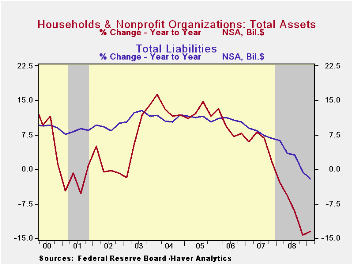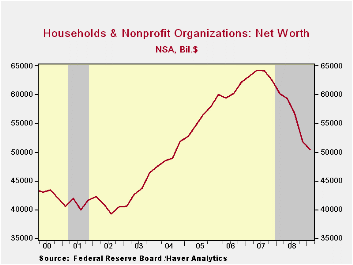 Global| Jun 12 2009
Global| Jun 12 2009U.S. Flow of Funds Indicate Further Shrinkage of Balance Sheets
by:Tom Moeller
|in:Economy in Brief
Summary
Since the peak in 2Q 2007, the net worth of the U.S. household & nonprofit sectors' has fallen by $13.8 trillion, or by nearly one-quarter. The decline to its lowest level since 2004 was led by the rapid shrinkage in asset values, [...]

Since the peak in 2Q 2007, the net worth of the U.S. household & nonprofit sectors' has fallen by $13.8 trillion, or by nearly one-quarter. The decline to its lowest level since 2004 was led by the rapid shrinkage in asset values, namely of stocks and real estate. Over just the last four quarters alone, the decline totaled $9.8 trillion. Over that period, the value of the household sector's financial assets fell by $7.9 trillion as the value of equity market shares fell by $3.3 trillion, or by 39.1% y/y, and mutual fund share values also fell by $1.3 trillion, or 28.4%. In addition, pension fund reserves were hit by $2.78 trillion during the year or by 21.2%. Tangible asset values suffered somewhat less than financial values but they still were down sharply. Over the last year, the value of tangibles overall dropped $2.2 trillion (-8.3%) as the reduction in real estate values totaled $2.3 trillion or 10.3%.
Accompanying the decline in the household sector's asset values was a reining in of liabilities. Total credit market liabilities of the household sector rose just 4.4% during the last four quarters, the weakest advance since 1954 (no typo). And all sectors pulled back their borrowing -- except the Federal government whose liabilities grew a record 28.3%. Non-government domestic liabilities retreated as the recession generated further deleveraging. These liabilities fell for the second quarter and were up a record slow 1.2% year-to-year. Credit market debt owed by the household sector dropped sharply for the second straight quarter (-0.6% y/y). After two quarters of breathtaking decline, mortgage borrowing inched up 1.6% (-1.0% y/y). Consumers also were of a mind to reduce credit liabilities which they did by a record $75.3 billion (-0.4% y/y). With the third decline in the last four quarters, the value of bank loans was up just 1.9% y/y, the least since 2005.
Credit market debt owed by the financial sector contracted and reversed roughly one-third of a 4Q rise. Year-to-year growth of 3.7% was down from a peak of 13.4% back in 2007. Liabilities of commercial banks rose 31.4% y/y but savings institutions liabilities fell for the fourth straight quarter (-25.3% y/y).
The liabilities of the foreign sector increased for the first quarter in the last three but year-to-year growth was a negative 9.0%.
Credit Quantity and Credit Quality: Bank Competition and Capital Accumulation from the Federal Reserve Bank of New York can be found here.
| Flow of Funds (Y/Y % Chg.) | % of Total | 1Q '09 | 4Q '08 | 2008 | 2007 | 2006 |
|---|---|---|---|---|---|---|
| Total Credit Market Debt Outstanding | -- | 4.4 | 5.2 | 5.2 | 10.1 | 9.9 |
| Federal Government | 11% | 28.3 | 24.2 | 24.2 | 4.9 | 3.9 |
| Households | 28% | -0.6 | 0.4 | 0.4 | 6.6 | 10.1 |
| Nonfinancial Corporate Business | 13% | 4.3 | 5.3 | 5.3 | 14.1 | 8.4 |
| Nonfarm, NonCorporate Business | 7% | 1.3 | 4.7 | 4.7 | 12.8 | 14.7 |
| Financial Sectors | 32% | 3.7 | 5.5 | 5.5 | 13.4 | 10.0 |
| Net Worth: Households & Nonprofit Organizations (Trillions) | -- | $50.376 | $51.706 | $51.706 | $62.191 | $62.206 |
| Tangible Assets: Households | -- | $24.221 | $24.782 | $24.782 | $27.102 | $28.288 |
| Financial Assets: Households | -- | $40.295 | $41.179 | $41.179 | $49.831 | $47.356 |
Tom Moeller
AuthorMore in Author Profile »Prior to joining Haver Analytics in 2000, Mr. Moeller worked as the Economist at Chancellor Capital Management from 1985 to 1999. There, he developed comprehensive economic forecasts and interpreted economic data for equity and fixed income portfolio managers. Also at Chancellor, Mr. Moeller worked as an equity analyst and was responsible for researching and rating companies in the economically sensitive automobile and housing industries for investment in Chancellor’s equity portfolio. Prior to joining Chancellor, Mr. Moeller was an Economist at Citibank from 1979 to 1984. He also analyzed pricing behavior in the metals industry for the Council on Wage and Price Stability in Washington, D.C. In 1999, Mr. Moeller received the award for most accurate forecast from the Forecasters' Club of New York. From 1990 to 1992 he was President of the New York Association for Business Economists. Mr. Moeller earned an M.B.A. in Finance from Fordham University, where he graduated in 1987. He holds a Bachelor of Arts in Economics from George Washington University.






